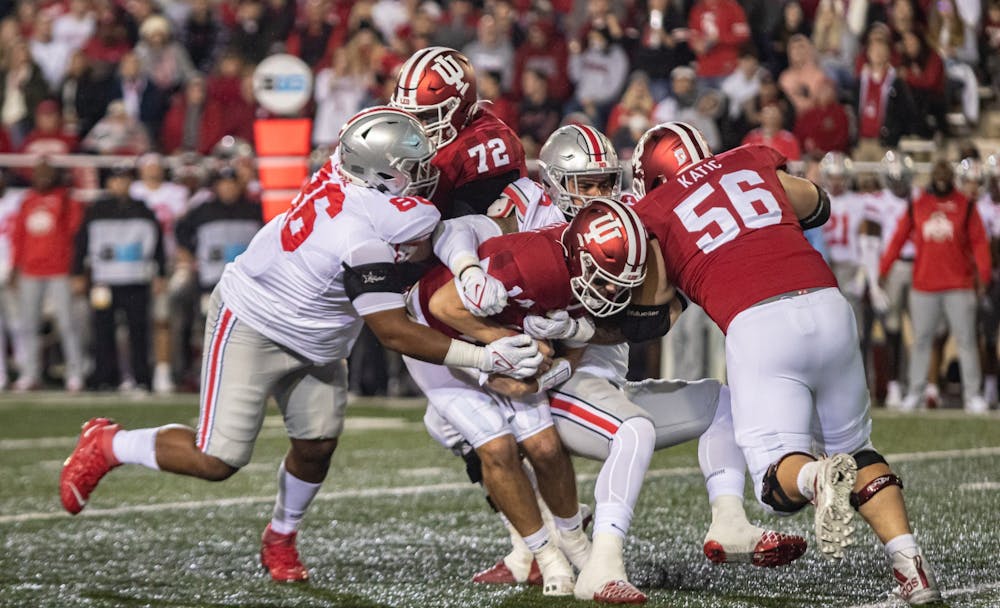In the weeks leading up to every college football season, sports bettors can wager money on a variety of potential outcomes. These include win totals, Heisman finalists and even whether certain head coaches will be fired.
You know what they can’t bet on? The odds of a team playing its fourth-string walk-on quarterback 18 minutes into a crucial game against a top-five opponent.
Well, oddsmakers should consider broadening their horizons because that’s exactly what Indiana football did Saturday night when sophomore Grant Gremel took the reins in a 54-7 blowout loss to then-No. 5 Ohio State.
To be perfectly honest, I had no idea Gremel was next in line behind freshman Donaven McCulley. I knew he and fellow sophomores Will Jontz and Zack Merrill were somewhere below McCulley on the depth chart, but any one of them could have stepped in Saturday night, and it would have seemed equally absurd to me.
Related: Indiana football faces quarterback uncertainty after series of injuries
Maybe that’s an indictment of my knowledge of Indiana football, but I simply don’t spend much time thinking about the team’s smörgåsbord of options at fourth-string quarterback.
At 2-5, Indiana has five more opportunities to pick up four wins and become perhaps the most battle-tested 6-6 team in recent history. The schedule from here on out appears much easier considering it only contains one potential top-10 team in No. 6 Michigan as opposed to the four top-10 teams Indiana faced in the season’s first half.
However, the games that once looked entirely winnable — at Maryland, versus Rutgers, versus Minnesota and at Purdue to close out the season — suddenly seem trickier with junior quarterbacks Michael Penix Jr. and Jack Tuttle week to week with injuries.
After week eight, the median number of touchdowns scored per game is 3.6 by Football Bowl Subdivision teams. Teams that have ascended to this mark include the mighty Arkansas State University and Florida International University, both of which are 1-6.
Where does Indiana stack up against those absolute titans? 2.3 touchdowns per contest, which ranks 118th in the country.
Of course, we can’t let outliers distract us. If you exclude their six offensive touchdowns against the University of Idaho, the Hoosiers score 1.7 touchdowns per game.
You might think the question at hand is how the Hoosiers can score, but they have plenty to answer before that.
Who is throwing the ball? Do the coaches even trust him to throw it? If they do, how long will that quarterback last until a blitzing linebacker completely flattens him and adds a new honoree to the prestigious Indiana injured reserve list?
Personally, I wouldn’t be surprised to see former Indiana quarterback Peyton Ramsey jog onto the field Saturday at Maryland.
Sometimes these columns feel like a brain teaser, an exercise in which I struggle to find new combinations of words to express the idea that Indiana’s offense is pretty bad. When I run out of words, I turn to numbers.
Statistically speaking, if Indiana could be merely average on offense — not good, not even great, but average — it would have beaten Michigan State and would have had a great shot of taking down everyone else except Ohio State.
Obviously, the Hoosiers’ slew of injuries doesn’t help their record. Still, I think there’s a certain chicken and the egg element to consider.
Related: COLUMN: Sad, funny or both? Examining Indiana football’s 54-7 loss to Ohio State
If, hypothetically, your quarterback is running for his life on every other play because his offensive line can’t protect him, his odds of getting hit very hard are very high.
To a certain extent, injuries are unavoidable. When you accumulate enough, they might even be insurmountable. But Indiana was playing nearly at full strength when Iowa shellacked it 34-6.
On one hand, Indiana almost certainly won’t lose as badly as it did to Ohio State. On the other, whether it’s by a field goal or seven touchdowns, simply failing to beat Rutgers at home might be even worse.
Saturday will mark Indiana’s long-awaited return to playing teams that look like Indiana, which is to say: not very good.
As a fellow mediocre Big Ten team, Maryland has its own fair share of vulnerabilities. However, it also has a very clear goal it must reach to defeat Indiana — score roughly 16 points.
For the Hoosiers, the path to victory is a bit less clear.




